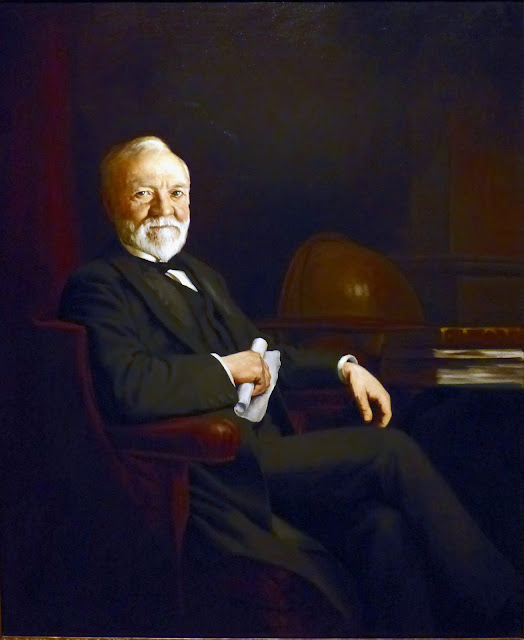This c. 1905 portrait of Andrew Carnegie (1835-1919) by an unidentified artist hangs in the National Portrait Gallery in Washington. DC.
"The individual who amasses great wealth, declared Pittsburgh steelmaker Andrew Carnegie in his 1889 essay 'Gospel of Wealth,' must in the end apply his fortune for the benefit of all. Having built one of the world's largest fortunes, Carnegie took his mandate seriously. During his lifetime, he turned over a staggering $350 million, or nine-tenths of his total wealth, for benevolent purposes. Carnegie's unprecedented largesse was matched only by its social impact. His Teachers Pension Fund raised instructional standards in colleges; his many library endowments provided Americans with a national system of public libraries; and the Carnegie Corporation, established in 1911, became the prototype for the great philanthropic foundations of the modern day. During the last years of his life, Carnegie devoted his energies to world peace, encouraging the great powers to settle their conflicts through arbitration rather than war." -- National Portrait Gallery
This 1861 photo of 24-year-old Andrew Carnegie appeared in The Civil War Through the Camera, where Carnegie's telegraphic contributions during the Civil War are discussed.
Andrew Carnegie
Superintended Military Railways
and Government Telegraph Lines In 1861
TELEGRAPHING FOR THE ARMIESANDREW CARNEGIE
The man who established the Federal military telegraph system amid the first horrors of war was to become one of the world's foremost advocates of peace. As the right hand man of Thomas A. Scott, Assistant Secretary of War, he came to Washington in '61, and was immediately put in charge of the field work of reestablishing communication between the Capital and the North, cut off by the Maryland mobs. A telegraph operator himself, he inaugurated the system of cipher despatches for the War Department and secured the trusted operators with whom the service was begun. A young man of twenty-four at the time, he was one of the last to leave the battlefield of Bull Run, and his duties of general superintendence over the network of rail-roads and telegraph lines made him a witness of war's cruelties on other fields until he with his chief left the government service June 1, 1862.
Meanwhile, Harvard has this 1902 caricature of Carnegie by Carlo de Fornaro, taken from Millionaires of America.







No comments:
Post a Comment